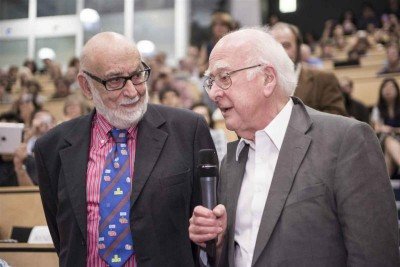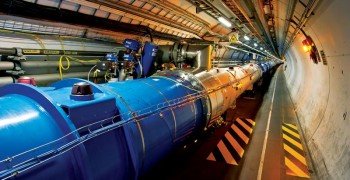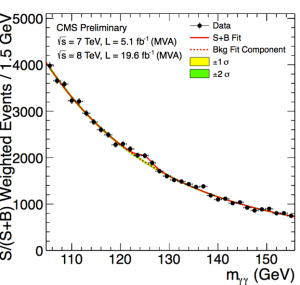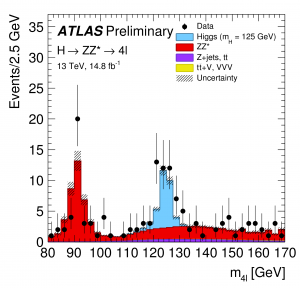Demystifying the experimental quest for the Higgs boson
Is the Higgs boson really the key to the masses of the elementary particles? How to demonstrate that hypothesis on the basis of high-energy physics data?
The Large Hadron Collider (the LHC) at CERN has solved that mystery a couple of years ago, resulting to the Higgs boson discovery in July 2012 and the 2013 Nobel Prize in physics.
This is a follow-up to my previous post on Higgs physics, turning this time on the experimental aspects of the Higgs boson quest.


[image credits: CERN 1 and CERN 2]
THE HIGGS BOSON AT THE LHC - THE CHALLENGE
Albert Einstein teaches us that mass is a form of energy. Therefore, in order to produce a very massive Higgs boson, one 'only' needs to build a powerful particle accelerator (or collider).
The acceleration process, which is achieved thanks to a strong electric field, increases the energy of the colliding particles that run into the accelerator. Thanks to a strong magnetic field, the trajectory of the colliding particles can be controlled so that one can make them collide. The energy released in the collision is then very large and sufficient to produce very massive elementary particles.
The Large Hadron Collider (LHC) at CERN is one of these accelerators. Protons are accelerated at a speed equal to 99.999999% the speed of light before colliding. The energy of the collision is then large enough for a Higgs boson (or any Standard Model particle) to be produced.
 [image credits: Wikipedia ]
[image credits: Wikipedia ]
Particle collisions however follow the probabilistic rules of the quantum world: one cannot determine the outcome of a given collision. One can instead only calculate the probability with which each specific result could occur.
Taking care of the maths (see here for details), we can show that during the first run of the LHC where 1 billion of proton-proton collisions were occurring each second, only a single of these collisions could be a Higgs boson event (a Higgs boson event is an LHC collision where a Higgs boson is produced).
Therefore, it does not seem trivial on how to find a Higgs boson in this large amount of data?
SEARCHING FOR THE HIGGS BOSON AT THE LHC
First of all, the Higgs boson is unstable (as most elementary particles) and it is thus indirectly observed through its decay products. The same story holds for most elementary particles so that a specific signature of a Higgs boson could also be a signature of other particles.
 [image credits: Wikipedia ]
[image credits: Wikipedia ]
In the above picture, the Higgs boson is the airplane and the air is our detector. In the particle physic world, we cannot directly see any airplane and are restricted to observe tracks in the air. The real challenge is then to distinguish the Higgs airplane from all other Standard Model airplanes (top quarks, weak bosons, etc) that fly billions times more.
Taking the example of a Higgs boson decay into a two-photon (or diphoton) system, it is necessary to distinguish this Higgs decay (our signal) from the electromagnetic production of a diphoton system that occur at a much larger rate. It is not clear how Higgs events could be observed within a huge stack of Standard Model background events.
The solution is to produce gazillions of collisions and impose a tight selection on the topology and the properties of the events that are considered as interesting. The Higgs boson properties are known theoretically, which can infer a clever selection implying that few background events will be selected, in contrast to a large quantity of Higgs events.
 [image credits: Jeffrey Hill ]
[image credits: Jeffrey Hill ]
After this event selection step, one obtains a given number of data events. The properties of these events can be compared to theoretical predictions, both in the context of the background-only hypothesis and of the background+signal hypothesis.
If the confidence-level is large enough, a discovery can be claimed.
JULY 4TH, 2012 …
The only issue is that the theory does not predict the Higgs boson mass, so that there is no hint about where to search and following which possible Higgs signature. Higgs boson searches have been performed in many channels and following several Higgs boson mass hypotheses.
As a consequence, the quest for the Higgs took 48 years!
On the 4th of July 2012, two presentations were held at CERN, one by the ATLAS collaboration and one by the CMS collaboration. Both collaborations have summarized and combined all their searches for the Higgs boson using all LHC data available at that time.
For both collaborations, the results were unambiguous: a discovery was claimed. In the language of statistics, this means that there was less than one chance out of almost 2 millions that the result was a statistical fluctuation of the non-Higgs background.
By the way, the Higgs discovery publications (that are also part of history now) are freely available from the web, and can be downloaded here for ATLAS and there for CMS.
To illustrate what this discovery look like, I present two examples of Higgs bumps below.
The figure on the left is related to the diphoton Higgs decay mode (which I have already discussed in this post) and the other figure describes the results of a search for a Higgs boson decaying into four charged leptons (electrons, muons and the associated antiparticles).


[image credits: the CMS and ATLAS collaborations]
THE HIGGS TODAY
More data has been recorded in the meantime and the results have been refined. With large statistics of Higgs events, the experimenters have started to measure the properties of the Higgs boson, confronting them to the predictions of the Standard Model. An amazing agreement has been found.
This is illustrated in the figure below where the strengths of the Higgs coupling to all elementary particles are measured as a function of the particle masses. We observe that the Higgs coupling strengths are proportional to the elementary particle masses, as predicted by the Standard Model.
 [image credits: inspire ]
[image credits: inspire ]
Last August, both collaborations have announced, at the ICHEP 2016 conference at Chicago, that they have rediscovered the Higgs bosons in the 2015-2016 data (that consists of collision data at a higher collision energy) in many channels, without needing to combine them.
in what way the research on Higgs boson drives the future of physics?
Well, it solves an issue in the Standard Model but brings many other questions. As a result, we believe that the Standard Model is only the tip of the iceberg. We have however no clue what lies beyond. Exploration is the keyword. And as for any exploration, we do not know what will be found.
Focusing on the Higgs itself, in order to fully understand the gauge symmetry breaking mechanism I was introducing in my previous post, we need to measure the Higgs self couplings: the one with three Higgses and the one with four Higgses. The former can be measured at the LHC at a very rough precision. The latter is not a game for the LHC.
Noet that there are also other questions motivating further searches, like those connected to dark matter.
I assume that the increase in computational power will be helpful in seeking those type of answers
For the theoretical predictions yes. There are a few calculations that cannot jsut be done because of CPU power.
For the experimental setups, the problem is more at the political level since we need a large amount of money to build the necessary experiments. The physics case is (more or less) clear, but then we need to convince the decision-takers.
I will read this in more detail in a bit. Always nice to have your expert explanations @lemouth.